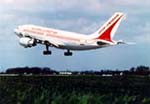

|
|
|
|
| HOME | BUSINESS | REPORT | |||
| September 14, 1999 |
Air-India eyes small aircraft for fleet expansion, offers sops to govt travellers
Air-India today said it had recommended the the purchase of 100- to 150-seater small capacity short range or SCSR aircraft and 200- to 250-seater small capacity long range or SCLR aircraft for its fleet expansion, a marked shift from the national carrier's original plan to get larger aircraft. While the SCSR would be ideal for high frequency, short flights to the Gulf (the Middle East) countries, the SCLR is expected to be much more financially viable on flights to destinations like London and Paris, Air-India Commercial Director Shanu Mukherjee said in New Delhi today.
Mukherjee said the fleet expansion was linked to Air-India finding a strategic partner and the latter issue had been put on hold. Although several airlines had shown interest to be Air-India's strategic partner, no talks had been held with them as yet. Regarding joining airlines alliances such as Star, he said work on the cost benefit analyses will start from October after which a decision will be taken. Mukherjee said Air-India, which continues to have a 20 per cent market-share in India, was better off by Rs 750 million between April and July this year than the corresponding period in 1998. Operational profits were achieved in May, June and July, he said. The airline would be ending the year in the minus by Rs 20 million to Rs 30 million as compared to Rs 800 million last year, he added. In an effort to win back clientele from the government sector, Air-India is also launching a family travel scheme from September 15 under which officials travelling abroad can take along one member of the family by paying just the surchage. Mukherjee said that the scheme will last till November 30 and is intended to give an impetus to officials of the government and public sector ''to come back to the national carrier''. He said an additional revenue of Rs 200 million to Rs 300 million was being expected from the govenment and public sector undertakings through this scheme. Air-India's regional director (north india) V K Verma said the government share in Air-India traffic was 40-45 per cent and this was expected to go up to 80 per cent. Under the scheme, one member of the immediate family will be allowed to accompany the official (above the rank of under secretary) to Paris, Osaka or Tokyo by paying Rs 5,000 surcharge for an economy ticket and Rs 10,000 for first class or executive class, Rs 8,000 and Rs 12,000 to London and Rs 12,000 and Rs 15,000 to New York or Chicago. The scheme is valid only for round trips and full fare tickets. The pro-rata outgo for interline travel of the family member, if any, shall be collected from the official while issuing the ticket. Upgrade or layover benefits will not be given if such a family ticket is availed of. Mukherjee said it was not right to say that Air-India had the government travel market captive. With the changes due to liberalisation, it was felt that the government sector should not be deprived of such benefits. For government and public sector officials, Air-India had already launched several incentives such as upgrade to next higher class, complimentary lay over of 24 hours in Tokyo, Osaka, Paris, London, New York and Chicago and special handling. Also, on direct ticketing, Air-India had also offered a 12 per cent discount on flown revenue on full fare tickets if the payment is made within 30 days of the billing. UNI
|
| Tell us what you think of this report | |
|
HOME |
NEWS |
BUSINESS |
SPORTS |
MOVIES |
CHAT |
INFOTECH |
TRAVEL |
SINGLES BOOK SHOP | MUSIC SHOP | GIFT SHOP | HOTEL RESERVATIONS | WORLD CUP 99 EDUCATION | PERSONAL HOMEPAGES | FREE EMAIL | FEEDBACK |
|